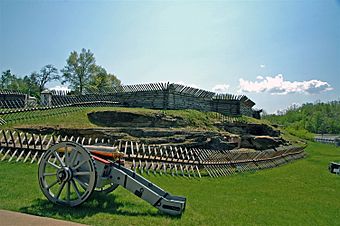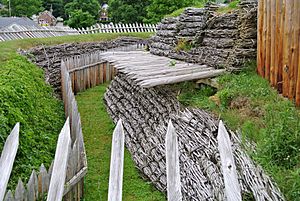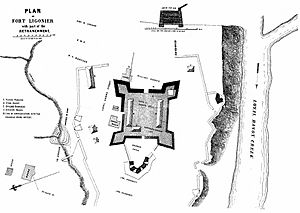Fort Ligonier facts for kids
|
Fort Ligonier Site
|
|
 |
|
| Location | South Market St, Ligonier, Pennsylvania |
|---|---|
| Area | 15 acres (6.1 ha) |
| Built | 1758 |
| Architect | Charles M. Stotz (reconstruction) |
| NRHP reference No. | 75001678 |
Quick facts for kids Significant dates |
|
| Added to NRHP | January 21, 1975 |
Fort Ligonier was an important British fort built during the French and Indian War. It is located in Ligonier, Pennsylvania, in the United States. The fort was a key spot for soldiers and supplies during the Forbes Expedition in 1758.
For eight years, Fort Ligonier was an active military base. It was never captured by enemy forces. The fort also served as a stopping point for soldiers traveling to the new Fort Pitt. During Pontiac's War in 1763, it was a crucial link for British messages and supplies. Native American forces attacked the fort twice and tried to surround it. This happened before the British won a big battle at Bushy Run in August 1763. The fort stopped being used by the military in 1766.
Today, you can visit a museum next to the rebuilt fort. The museum has many items found from the battles. You can take a tour of the fort and learn about its history. During special events like Fort Ligonier Days, the fort's cannons are even fired!
Building Fort Ligonier: A Key Part of the War
In the mid-1750s, France had won important battles against British forces led by George Washington and Edward Braddock. This gave France control of the important forks of the Ohio River, where the city of Pittsburgh is today.
By 1758, General John Forbes of the British Army was given a very difficult job. He had to capture Fort Duquesne, which was the main French fort at the forks of the Ohio River. To do this, General Forbes ordered a new road to be built across Pennsylvania. Along this road, a series of forts were constructed to protect it. The last fort in this chain was called the "Post at Loyalhanna." It was about 50 miles from Fort Duquesne.
Workers began building Fort Ligonier in September 1758. By late October, George Washington had arrived at Loyalhanna. Before that, British forces had been defeated at Fort Duquesne on September 14. However, the British successfully defended Loyalhanna from a French attack on October 12.
The French forces were greatly outnumbered and had lost support from their Native American allies. Because of this, they decided to leave Fort Duquesne. General Forbes and his troops took over the fort on November 25. He named the site "Pittsburgh" to honor William Pitt, who was a very important British government official. Forbes also named Loyalhanna "Fort Ligonier" after his boss, Sir John Ligonier, who was the commander-in-chief of the British Army.
Key Dates in the Fort's History
- August 10, 1758—Colonel Bouquet told Major James Grant to build a road from Bedford to Ligonier. This location was close enough to attack the French Fort Duquesne.
- August 15, 1758—Colonel Bouquet sent Ensign Charles Rohr, an engineer, to the future site of Fort Ligonier. His job was to pick the best spot for a supply storehouse.
- August 20, 1758—Colonel Bouquet sent Major Grant, Colonel James Burd, and 1,500 men to the site. They began building the fort. Major Grant was in charge of the fort and the men.
- August 21, 1758—Ensign Rohr chose the exact location for the fort.
- August 22, 1758—Colonel Bouquet ordered Colonel Burd's men and some artillery soldiers to build a 120-foot (37 m) storehouse for supplies and a hospital.
- August 27, 1758—Burd and Rohr found a better location for a fort about 9 miles (14 km) west of Ligonier. But General Forbes said to keep building Fort Ligonier since work had already started.
- August 29, 1758—Colonel Burd and his troops arrived at Fort Ligonier and dug trenches around the fort for defense.
- September 1, 1758—Bouquet sent 100 men to dig trenches at a place called "Grants Paradise" south of Latrobe, Pennsylvania.
- September 9, 1758—Major Grant left Fort Ligonier with his troops and headed west toward Fort Duquesne. On September 15, he got within five miles (eight km) of Fort Duquesne. However, the French defeated his forces. His plan to trick the fort's defenders into an ambush went wrong. Bouquet arrived at Fort Ligonier with troops. He wrote about the fort's condition, the area, and the supplies.
- October 12, 1758—While the fort was still being built, the Battle of Fort Ligonier took place. The French attacked for four hours but were defeated. The French tried to attack again at night, but mortar fire from the fort forced them to leave.
- November 12, 1758—Colonel Forbes's troops found another group of French soldiers near Fort Ligonier. The British attacked, killing one and capturing three. One prisoner was an Englishman who had been taken from his home in Lancaster County by Native Americans. He and the French prisoners shared information that Fort Duquesne was weak. Because of this, Forbes decided to push forward and capture Fort Duquesne.
- November 12, 1758—Units led by George Washington (1st Virginia) and Lieutenant Colonel George Mercer (2nd Virginia) accidentally fought each other. This happened in heavy fog and at night. Two officers and 38 men were killed or wounded.
- November 1758—About 4,000 troops were staying at the fort. This made Ligonier the second-largest community in Pennsylvania at that time.
- November 25, 1758—Forbes successfully captured Fort Duquesne.
- March 1766—Fort Ligonier was no longer used by the military after the French and Indian War ended.






